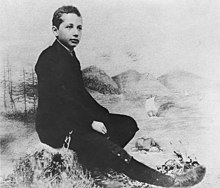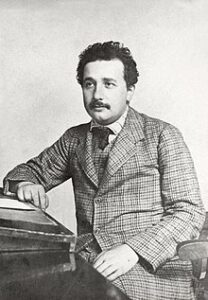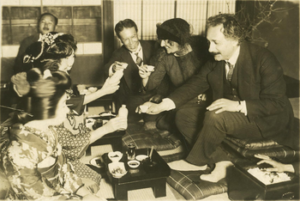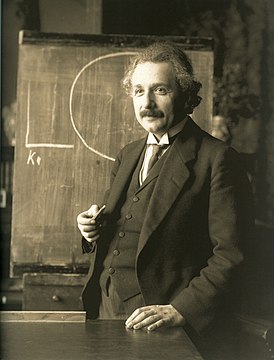Origin, early years and education
On March 14, 1879, Albert Einstein was born into an impoverished Jewish family in Ulm, Germany. The Einsteins relocated to Munich in the summer of 1880, where they founded a business making electrical machinery.
 Albert Einstein started attending the Luitpold Gymnasium in 1888, having completed his elementary education at a nearby Catholic school. His strongest subjects were Latin, physics, and math. In addition, he enjoyed reading books on philosophy and science, particularly Immanuel Kant’s Critique of Pure Reason and Euclid’s Elements. He went on to say that he rejected the drill-and-cram approach to typical German schooling during these years and instead became independent in his thinking.
Albert Einstein started attending the Luitpold Gymnasium in 1888, having completed his elementary education at a nearby Catholic school. His strongest subjects were Latin, physics, and math. In addition, he enjoyed reading books on philosophy and science, particularly Immanuel Kant’s Critique of Pure Reason and Euclid’s Elements. He went on to say that he rejected the drill-and-cram approach to typical German schooling during these years and instead became independent in his thinking.
Owing to financial difficulties, the family relocated to Italy in 1894, initially settling in Milan and later in Pavia. This is where Albert Einstein penned “On the study of the state of the ether in a magnetic field,” his debut scientific publication. He attempted to enroll in the esteemed Polytechnic School (Polytechnicum) in Zurich in 1895. Despite passing the physics and math entrance exams, he was unable to pass the general exam, and he was also without a secondary education certificate, which he obtained in September 1896 from a school in the Swiss town of Aarau at the recommendation of the Polytechnic’s director and instructors, who were His skills astounded us, and we suggested that he apply the next year. Without taking any tests, Einstein enrolled in the Polytechnic in October 1896. He was certified to teach mathematics and physics in 1901. After obtaining Swiss citizenship (which he had until his passing), he joined the Swiss Patent Office in Bern in 1902 and worked there as a technical expert until 1909.
“Year of Miracles”
Einstein’s work schedule at the agency permitted him to pursue scientific studies. The reputable German journal “Annals of Physics” published three of his articles in 1905 that had a profound impact on fundamental physics; this period would later be known as the “year of miracles”; the first was on relativity (“Towards the electrodynamics of moving media”), the second discussed the Brownian motion of particles affected by single-molecule impacts (“On the movement of particles suspended in a fluid at rest, required by the molecular kinetic theory of heat”), and the third provided a theoretical explanation of the photoelectric effect (“On one heuristic point of view concerning the origin and transformation of light”).

The study on the special theory of relativity (STR) was the most extreme of the three revolutionary articles. The “theory of the world ether,” which was prevalent at the time, was challenged by Einstein, who also established the groundwork for the special and general theories of relativity. He also derived a formula for the relationship between mass and energy, which he expressed in the form E = mc^2, which served as the foundation for the relativistic principle of energy conservation of all nuclear energy.
Academic activities
Einstein presented his PhD dissertation defense (on Brownian motion) in 1906. He provided a quantum explanation of the body’s heat capacity during temperature fluctuations in 1907. He received a speaking invitation from the University of Bern in 1908. He was appointed extraordinary professor (associate professor) at the University of Zurich in 1909, and he had to become an Austro-Hungarian Empire subject in order to be appointed as an ordinary professor at the German University in Prague in 1911. He authored eleven scientific publications while residing in Prague, five of which were with quantum theory of solids and radiation mathematics.
Returning to Zurich in 1912, Einstein was appointed professor at the University of Berlin, head of the Kaiser Wilhelm Institute of Physics, and fellow of the Prussian Academy of Sciences in 1914. That same year, he re-acquired his German citizenship and resided in Berlin until 1933, when he was forced to leave to the US due to political reasons (he obtained US citizenship in 1940). He came to Princeton to teach physics at the newly established Institute for Advanced Study in the United States, where he stayed until his retirement in 1945.
Contribution
A significant contribution to the advancement of physics and allied sciences was made by Albert Einstein. His creations include the statistical theory of Brownian motion, the photoelectric effect, the special (1905) and general (1907–1916) theories of relativity, and quantum theories of heat capacity. Einstein predicted the presence of gravitational waves in 1916, which were empirically proved in 2015, and created quantum statistics, also known as Bose-Einstein statistics.
While working on cosmological issues in his latter years, he focused much of his energy on developing a single field theory that would bring together the physics of the macro- and microworlds.
More than 300 works on physics have been produced by scientists, in addition to around 150 books and articles on the history and philosophy of science, journalism, etc.
Political Views
Albert Einstein advocated for global, peaceful ideologies. He signed the 1914 declaration against Germany’s entrance into the First World War, which referred to nationalism as “the measles of mankind.” talked scathingly about the horrors committed by the Nazi dictatorship in the 1930s.
 He relinquished his German citizenship, his membership in the Prussian and Bavarian Academies of Sciences, and his connection with the scientists who stayed in Germany after moving to the United States. His signature on a 1939 letter to US President Franklin D. Roosevelt regarding the threat of nuclear weapons development in Germany had an impact on the US government’s decision to launch the Manhattan Project.
He relinquished his German citizenship, his membership in the Prussian and Bavarian Academies of Sciences, and his connection with the scientists who stayed in Germany after moving to the United States. His signature on a 1939 letter to US President Franklin D. Roosevelt regarding the threat of nuclear weapons development in Germany had an impact on the US government’s decision to launch the Manhattan Project.
opposed the use of nuclear bombs between 1940 and 1950. He was one of the founders of the Pugwash movement, a group of scientists that advocated for nuclear disarmament, and he supported the Russell-Einstein manifesto, a document-appeal signed by eleven eminent scientists that urged all nations to pursue peace, disarmament, and cooperation in order to prevent nuclear war. The manifesto was released on July 9, 1955, following Einstein’s death.
He was sympathetic to socialist ideologies. According to US intelligence agencies—the FBI possessed a dossier that spanned almost 1,500 pages—Einstein was a Soviet agent.
Awards and personal information
Recipient of the Physics Nobel Prize (1921) “for services to theoretical physics and especially for the discovery of the law of the photoelectric effect.” Awarded honorary memberships at several international institutions (such as Oxford, Harvard, Sorbonne, etc.) and science academies, such as the USSR Academy of Sciences (1926). He was listed as a Personality of the 20th Century by Time magazine in 1999.
He met Mileva Maric (1875–1948), a Serbian, when he was still a student, and they were married in 1903. This marriage resulted in the boys Hans Albert (1904-1973) and Eduard (1910-1965; schizophrenia sufferer), as well as a girl, Lieserl (1902–1903; other accounts claim she was placed in an orphanage or adopted by another family). Einstein promised Mileva Maric the Nobel Prize upon their 1919 divorce, which he was confident would be granted shortly after. He then gave Maric the money that he had received. After consenting to adopt two girls from her first marriage, Einstein married his cousin Elsa (1876–1936) three months after their divorce.
The violin was performed by Albert Einstein. He was a devotee of eighteenth-century classical music. He liked to read philosophy and fiction books and to garden in his free time. He had a lifelong love of sailing and enjoyed spending time on his own boat.
Demise
passed away in Princeton, New Jersey, USA, on April 18, 1955. An aortic aneurysm was listed as the cause of death. He requested in his will that there not be a lavish burial; just twelve close pals attended his final goodbye. His remains were dispersed.
